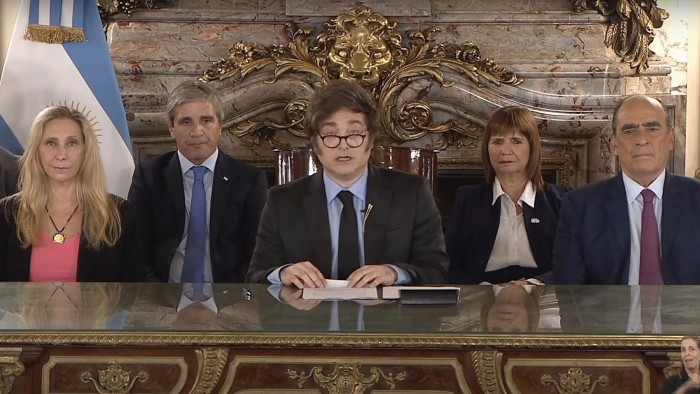Unlock the Editor’s Digest for free
Roula Khalaf, Editor of the FT, selects her favourite stories in this weekly newsletter.
The Argentine peso, Javier Milei told voters while seeking the presidency, was “worth less than excrement”. His solution? To replace it with the US dollar and burn down the central bank.
Eighteen months later, Milei has instead persuaded the IMF and other lenders to stump up $42bn to help a reinvigorated central bank support the peso, on top of $44bn already lent. Plans to dollarise overnight have been replaced by a gradual evolution towards a “bimonetary system” featuring pesos and dollars.
The peso’s new lease of life comes with greater freedoms. From this week, it will float against the dollar in a much wider band and most restrictions on buying foreign currency have been scrapped (though companies must still wait to send home profits from previous years).
So, $86bn of international support later, will Argentines continue to view their national currency as bodily waste?
The first response from financial markets was positive. Yet long-suffering investors might be forgiven some scepticism. This is the fund’s 23rd bailout of the serial South American defaulter and most of the previous 22 did not end well. One of Milei’s reform-minded predecessors, Mauricio Macri, promised to “change history forever” before being forced back to the IMF less than a year later for yet another rescue.
This time there is an important difference. Argentina has a government that is serious about fighting inflation by living within its means. Even hardened cynics have been surprised at how firmly Milei has stuck to his pledge to slash spending and run budget surpluses, instead of the deficits to which Buenos Aires was addicted for decades, including under Macri.
The libertarian leader has also unleashed a wave of deregulation in what was one of the world’s most closed economies, removing the state from myriad areas of business where it had intruded to raise costs without delivering benefits. He has been frank with voters about the pain they must endure before the economy is turned around.
So far, so good. But despite the much-trumpeted progress on eliminating the deficit and staving off the risk of hyperinflation, other Argentine vices have proved harder to break. The central bank may not be printing pesos merrily to fund spending, as it did under previous Peronist governments, but the supply of money in the economy is still rising fast.
Steve Hanke, professor of applied economics at Johns Hopkins University, points to rapid monetary expansion as a problem. Argentina, he says, “is not going to come close to hitting the consensus inflation forecast of 23 per cent for this year because the money supply is growing way too fast. Monetary policy is way too loose.”
Prices jumped 3.7 per cent in March — the highest monthly figure since last August and an unwelcome reminder for Milei that the inflation dragon is far from slain. The decision to float the peso’s official rate has already led to an effective devaluation of about 10 per cent in just two days, putting further pressure on prices.
In reality, neither the fund nor Argentina had many options. With Buenos Aires unable to build dollar reserves, the fund had little chance of being paid back the $44bn it had disbursed from the previous bailout. Milei could not continue with tight exchange controls that were deterring investment and distorting the exchange rate (some prices in Buenos Aires are approaching European levels).
“The Achilles heel of the Milei programme was the lack of reserve accumulation and the out of line exchange rate,” says Alejandro Werner, a former senior IMF official now at Georgetown University. “That had to be fixed and this is a good deal to fix it, given the political context.”
Milei fears what a higher inflation rate would do to his prospects for crucial midterm elections in October, where he needs to win a lot more seats in congress to have a chance of cementing his reform programme in law.
Yet the fund persuaded him to scrap most exchange controls now and float the peso in a wider range, even if the upper limit is lower than some in the IMF would have liked.
“The currency conundrum the government was facing delivered no cost-free exit,” says Alfonso Prat-Gay, a former economy minister and central bank president. “This is the least bad option in the short term and probably the best for the medium term.”
Whether last week’s IMF deal persuades Argentines that their pesos are worth holding, rather than hastily scooping up and disposing of, remains to be seen.
michael.stott@ft.com
https://www.ft.com/content/08f6a6fd-56d0-4950-877c-f29f4515b48c


